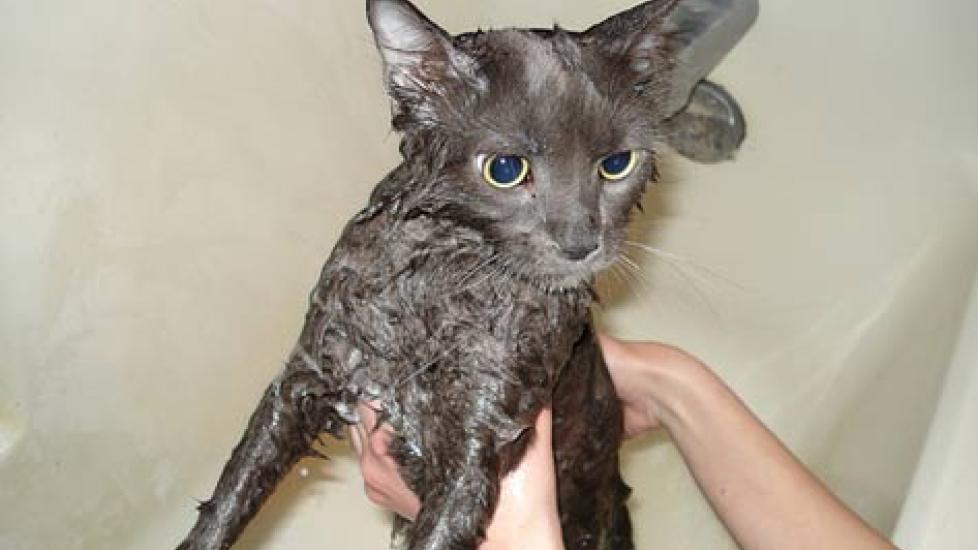'Natural' Methods for Controlling Fleas in Cats
By Jennifer Kvamme, DVM
There are a lot of different options available for cat owners who are being faced with fleas. But not everyone is interested in using chemicals to deal with these pests. In fact, a growing number of people are trying to avoid chemical solutions. There are some options available that are considered more nature-based. For those who want to go the less-toxic route, here are a few of the options to consider.
You may find that some of these "home remedies" work great the first year and then become less effective over time. Depending on the level of flea infestation you are experiencing and your diligence in combating the critters, you may have to work harder one year versus the next. While these methods are safer, you will find that they are more effective at preventing flea problems than eliminating established infestations. Also, no single method is going to work 100 percent, so it may be necessary to combine a few different methods to reduce the level of infestation present in your home and on your cat.
If your cat spends lots of time outdoors, you will probably have more difficulty controlling fleas naturally, since they may be strongly established in the yard (or wherever your cat frequents) as well as in the home. Be aware that not every flea control method will work for every situation. You may need to use one method for the yard, another for the home and yet another for your cat’s body.
Caring for the Cat
Your cat can benefit from a simple and thorough rinse with cool water to expel fleas from the body and hair. Following the water bath, using a cedar, eucalyptus, lavender, or citrus-infused shampoo may help to keep fleas at bay -- they are all known flea repellants. Cedar can be used in the home to repel fleas from areas where your cats sleep, and some people have found that fennel leaves rubbed into the cat’s coat can discourage fleas as well.
Keeping your cat’s haircoat and skin healthy is important. Adding extra omega-3 fatty acid supplements to your cat’s diet will improve skin health. This is especially helpful for protecting the skin from drying out when you are using regular shampooing for eliminating fleas from the haircoat.
If your cat hates water to the point that it is all but impossible to bath him regularly, using a flea comb (made with very close-set teeth) will physically pull the fleas from the cat’s body. You will need to make sure the comb gets down close to the skin, but you will need to work slowly, as the comb may pull on the hair while you are dragging it through. Have a bowl of soapy water nearby when you use the comb so you can drown the fleas as you remove them. They can’t be squashed with your fingers and will jump quickly away if you are not fast. While combing, concentrate on the areas of your cat’s body where fleas like to hide, like the groin, armpits and base of the tail.
Caring for the Home Environment
Adult fleas will lay eggs in your cat’s bedding, deep in the carpet, and almost everyplace your cat frequents, so you won’t be able to get rid of the entire population of fleas by simply combing and washing your cat. You will need to be sure to also clean and treat the household and yard when fighting fleas.
Fortunately, vacuuming is very effective for dealing with cat fleas. You will need to be very diligent in vacuuming and cleaning the inside and outside of your home when dealing with fleas, and you will need to do it frequently in order for it make a real difference. You may wish to initially have your carpets professionally cleaned to help remove some of the deposited eggs and larvae, but this will not eliminate the problem entirely. You will need to vacuum all of the surfaces of your house every few days (disposing of the vacuum bag at least weekly) and wash all of your cat’s bedding almost as often.
Salt may be sprinkled into the carpet to work as a desiccant (drying agent) to kill flea eggs and larvae deep in the fibers of the carpet. However, salt would not be a good solution for those who live in areas of the country with higher humidity levels (such as Florida), as it can absorb water and result in mildewed carpet.
The outside yard will also need to be kept free of debris (piles of leaves, etc.) to help reduce places for fleas to congregate. Planting certain herbs and plants in the yard may help direct fleas away from your property. Lavender, eucalyptus, fennel, marigold, and citrus, all known flea repellants, can make your yard less interesting to these pests.
Diatomaceous earth can be used to treat the yard without chemicals. You will want to look for a natural or food-grade diatomaceous earth for use around humans and pets. This material is made from a ground-up stone (made up of tiny fossils) that is similar to a pumice powder, which acts as an abrasive and drying agent, much like boric acid does. And like boric acid, it is also in a dust form that can be spread in the yard and even on carpeting. Keep in mind that you may need to reapply it after a particularly heavy rain as it can be washed away.
***
It is always best to err on the side of caution when using something on or around your home, your family, and your precious pets. Be sure to get the advice of your veterinarian before using any products to control fleas, even those touted as "natural."
Image: Mac Armstrong / via Flickr
